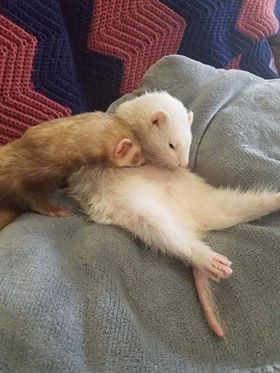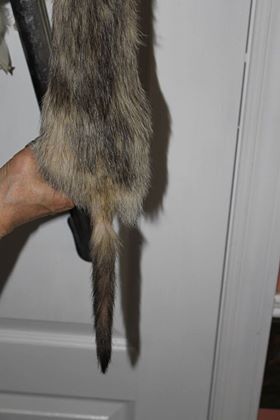Dish Soap, Fleas, and Blackheads
Summary: HFF does NOT advise the use of dish soap for ANY purpose aside from emergency decontamination. Dish soap is unnecessarily harsh. It strips natural oils and over-dries the skin and coat. It can also cause significant irritation and adverse reactions in both the skin and airways.
It has become increasingly common for people to recommend bathing pets with dish soaps (e.g. Dawn) for various reasons, including for fleas and blackheads/rat-tail. Unfortunately this common recommendation is inadvisable.
Dish soaps contain chemicals known as “detergents.” Detergents are molecules that break apart and surround lipids (oils, fats), allowing them to then be dissolved in water and removed. This property is what makes dish soaps so useful for emergency situations such as decontamination in oil spills. However, those emergency situations are the only time that dish soaps should be used on pets.
Most soaps contain detergents but dish soaps, specifically designed to break apart tough oils from cooking, contain particularly strong detergents. These strong detergents do not discriminate between “bad” and “good” oils and along with any unwanted substances will strip important, healthy oils from the skin and coat. This stripping of the natural oils is drying and damaging to the skin and fur. In addition to the harsh, drying effects of the detergents, many dish soaps contain other harsh chemicals that can irritate sensitive ferret skin and airways and in rare cases can cause severe reactions. Furthermore, the relatively high pH of dish soap compared to the natural pH of our pets’ skin (dogs, cats, and ferrets) can cause damage to the skin barrier which increases risk of burns, irritation, reactions, and increased susceptibility to a variety of skin infections.
From the WSU College of Veterinary Medicine: “A mild hypoallergenic soap that’s formulated for veterinary use is all you need.” “Formulated for veterinary use” means a product that’s designed to work with a dog’s body. While dish soap or your favorite shampoo might strip away the dirt, and more importantly the odor, from your pet’s coat, it will also strip natural oils from their fur and may irritate their skin.“
Below is a helpful informatic that, while geared towards dogs, also applies to ferrets and cats:

From The National Association of Professional Creative Groomers (the NAPCG) Facebook Page: “Household cleaning products such as Dawn dish soap should never be used on pets. Although Dawn used to be a go to product for dogs with fleas, there are now much safer options for both professional groomers as well as pet owners. The company who manufactures Dawn, Proctor & Gamble, advise that Dawn should NOT be used on pets.
Thank you to our friends at Pure Paws pet products for providing a visual to make our fans aware of products they should avoid to keep their pets happy and healthy!”
[See Pure Paws’ blog post HERE]
For more info on the use of detergents and their harmful effects on pet skin, read: Epi Pet’s Article: Dish Soap and the Companion Animal
Fleas:
Unfortunately, it is commonly recommended to bathe pets with dish soap to kill fleas (but this should NOT be done). The detergents in soaps not only remove oils, they also break the surface tension of water. Fleas are very light-weight, and have a waxy (water-repellent) surface that allows them to float on water surfaces and resist drowning in plain water. Detergents break the surface tension of water, which in theory prevents fleas from being able to float on the surface. They also (in theory!) break apart the waxy coating on the flea’s surface and airways, enabling them to inhale the water and drown.
HOWEVER, while dish soap may indeed help to kill fleas, it is UNNECESSARILY HARSH. Rather than using a dish soap with harsh chemicals and strong oil-stripping, skin-drying detergents, a simple, gentle soap is all that is needed. Soaps should be hypoallergenic and formulated for veterinary use (see the quote from WSU above). Soaps or shampoos designed for humans should be avoided. Pet skin and human skin are very different and many human skin and hair products contain ingredients that may be irritating or downright harmful to pets.
Additionally, soaps (of any kind) offer only a temporary solution; they will NOT help with the underlying infestation. Please Read: Dish Soap – Not a Good Flea Treatment.
So how do I treat fleas….?
If your ferret or any pet in the house has fleas, you should contact your vet immediately. The best treatment for fleas is immediate treatment with a veterinary prescribed flea medication, which may take 4-36 hours to kill the existing fleas. In the meanwhile to remove fleas at home (while you wait for your vet appointment), you can do a warm soak with a gentle soap (NOT dish soap), followed by very careful combing with a flea comb.
There are many available medications that your vet might prescribe to treat fleas. Some of these have the additional benefit of also treating ear mites (a common problem in ferrets), and preventing heart worm. Some of the more commonly used treatments include Kitten Revolution, Advantage, Advantage-Multi, and Frontline. Both Revolution and Advantage-Multi treat ear mites and prevent heart worm. Frontline will kill ticks, but does NOT treat mites or prevent heart worm.
When one animal has fleas, all animals in the household should be treated. All animals in the household should be treated with one application of medications a month, and should be treated for at least 3 months.
In addition to treating all of the pets, the entire house and any cages or play areas need to be carefully cleaned. All carpets and upholstery should be thoroughly and frequently vacuumed. If possible, steam cleaning carpets and upholstery can help to remove not only fleas, but eggs that may be hiding in the material. Bedding should be washed in hot, soapy water at least weekly. The flea life-cycle can span weeks to months, so regular and thorough cleanings should be repeated a minimum of weekly for at least 3 months. If you have a severe or repeated flea infestations, you may consider seeking information on having your house professionally treated.
For more information on treating fleas see:
Rat Tail:
Another common and misguided use of dish soap is to treat blackheads on ferret tails. It is common for some ferrets to get “rat tail” in the summer season. Even altered (neutered/spayed) ferrets will experience slight hormonal changes in the spring and summer, leading to an increase in oil production in the skin. In some cases ferrets will develop rat tail. The fur on their tail will thin from the tip up (rather than from the tail base or hips/butt down as in Adrenal Disease), and an abundance of blackheads may be visible.
Rat tail is a purely cosmetic issue and does NOT require treatment. Washing your ferret to treat the blackheads is not only ineffective, it also strips the natural oils from their skin (read above). This will dry the skin, which then kicks the skin’s natural oil glands into over-drive causing them to produce MORE oils, which can make the problem much worse rather than better, and can also increase your ferret’s odor. Rat tail is a cosmetic issue only, and is temporary. As summer wanes and your ferret returns to winter mode, the blackheads will improve and the tail’s fur will regrow with the winter coat.
IF the rat tail does NOT resolve in the winter, OR if the fur loss extends to the base of the tail or other parts of the body, then the fur loss is likely due to Adrenal Disease rather than seasonal rat tail, and your ferret needs to be evaluated by a veterinarian.
Below are some pictures of Rat Tail fur loss on the tail. Note that the fur loss starts on the TIP of the tail and moves up, and ONLY includes the tail. Fur on the tail base, hips, and body is normal:

Photo Credit: Heather Downie

Photo Credit: Amanda Codlin
Below are some pictures of Adrenal Disease fur loss on the tail. Note that the fur loss starts at the BASE of the tail, and may extend to the hips, and other parts of the body:

Photo Credit: Heather Downie
References:
Brown, S. (2012). Flea control for ferrets. Veterinary Information Network. https://www.veterinarypartner.com/Content.plx?P=A&S=0&C=0&A=3355. Published 3/7/2012. Accessed May 23, 2017.
Caligur, V. (2008). Detergent properties and applications. Sigma-Aldrich Co. LLC. http://www.sigmaaldrich.com/technical-documents/articles/biofiles/detergent-properties.html. Published 2008. Accessed May 23, 2017.
Dany. (2015). #Dogs are not dishes. http://store.purepaws.net/Dogs-are-not-Dishes-_b_10.html Published July 29, 2015. Accessed May 23, 2017.
Does Dawn dish soap kill fleas. Flea Science. http://fleascience.com/flea-encyclopedia/life-cycle-of-fleas/adult-fleas/how-to-kill-fleas/does-dawn-dish-soap-kill-fleas/. Published: Unknown. Accessed May 23, 2017.
Drake, L. Dish soap and the companion animal. http://www.epi-pet.com/Dish%20Soap%20and%20the%20Companion%20Animal.pdf. Published: Unknown. Accessed May 23, 2017.
Dryden, M. (2009). How you and your clients can win the flea control battle. DVM 360. http://veterinarymedicine.dvm360.com/how-you-and-your-clients-can-win-flea-control-battle?id=&pageID=1&sk=&date=. Published March 1, 2009. Accessed May 23, 2017.
Hoggan, S. (2001). University. Bathing your dog. College of Veterinary Medicine at Washington State University. https://www.vetmed.wsu.edu/outreach/Pet-Health-Topics/categories/procedures/dogs/bathing-your-dog. Published 2001. Accessed May 23, 2017.
Lewington, J. (2007). Ferret Husbandry, Medicine, and Surgery, 2e. Philadelphia, PA: Elsevier.
National Association of Professional Creative Groomers (the NAPCG) Facebook Post. https://www.facebook.com/NAPCG/photos/a.403062048391.180125.226834098391/10152132596128392/?type=3&theater. Published April 2, 2014. Accessed May 23, 2017.
Soapy science: How do detergents work. Science on the Shelves. https://www.york.ac.uk/res/sots/activities/soapysci.htm. Published March 2003. Accessed May 23, 2017.
Wiggelsworth, V. (1953). Surface Forces in the Tracheal System of Insects. Quarterly Journal of Microscopical Science. 94 (4): 507-522.
